



A Survey of Commercially Available Broilers Originating from Organic, Free-range, and Conventional Production Systems for Meat Yield, Composition, and Relative Value
By Ryan Husak, Graduate Research Assistant; Joseph Sebranek, University Professor of Animal Science and published in the Animal Industry Report 2007, by the Department of Animal Science, Iowa State UniversitySummary and Implications
The current survey can be used by consumers when considering the choices of organic, free-range, and conventional broiler meat and determine if the price of the product is reflective of added value.
Introduction
Organic and free range broiler meat has become increasingly available to consumers. Conventional broiler meat dominates the market by volume but organic and free range alternatives are beginning to gain popularity due to consumers’ perception of environmentally friendly production methods and perceived enhanced meat quality characteristics. Due to large price differences between organic, free-range and conventional broiler meat, it is essential to compare the types on the basis of relative value. The objective of this survey was to investigate qualitative and quantitative properties of meat from organic, free range, and conventional broilers as marketed to the general consumer.
Materials and Methods
Fifteen broilers from four suppliers of organic, free-range, and conventional birds were purchased and immediately frozen. Broilers were evaluated for pH, color, lipid oxidation, proximate composition, meat yields, fatty acid composition, cooked yield, sensory attributes and monetary retail variation.
Results and Discussion
Organic broilers yielded more (P<0.05) dark meat on a raw basis (Figures 1) compared to free-range and conventionally raised broilers. The yields were not generally different among suppliers. Protein content of raw organic and free range breast and thigh meat was higher (P<0.05) compared to conventional breasts and thighs but the differences were not large enough to be of practical concern. Cooked organic breast and thigh protein content was also higher (P<0.05) than conventional, similar to the raw products. Raw organic breasts and thighs were darker and less yellow (P<0.05) in color when compared to free-range and conventional breasts and thighs. Cooked color values for organic and free-range breast, thighs and skin were also less (P<0.05) yellow compared to conventional.
Ultimate pH for organic breast meat was higher (P<0.05) when compared to free range and conventional values. Organic thigh meat ultimate pH was higher (P<0.05) than the free-range thigh values potentially indicating a lower glycolytic potential. Raw free-range breast and thigh thiobarbituric acid values, which are a measure of rancidity, were lower (P<0.05) when compared to that of organic and conventionally raised broilers. Free-range whole carcass cooked yields were similar to organic (P>0.05) but higher when compared to that of conventionally raised broilers. Fatty acid analysis (Figures 3 and 4) indicated that organic breasts and thighs contained less (P<0.05) saturated and monounsaturated fatty acids and more (P<0.05) polyunsaturated, omega-3, and omega-6 fatty acids when compared to free-range and conventionally raised chickens. Results from the trained sensory panel (Figures 5 and 6) indicated that conventional thighs were more tender (P<0.05) and less chewy (P<0.05) when compared to thighs from free range and organic broilers. Other sensory parameters were not significantly (P>0.05) different among attributes for breasts and thighs.
At the time of the study, in the spring of 2006, the average retail price for whole broiler chickens (averaging 4 brands per type) were $3.19, $2.78 and $1.29 per pound for organic, free range and conventional whole broilers respectively. Although polyunsaturated fatty acid composition was significantly higher for organic broilers; meat yields, proximate composition, and sensory qualities, in practical terms, did not show differences. Therefore, consumers are basing purchase decisions on more than the quantitative and qualitative attributes evaluated in this study, and are probably including intangible values related to the different production systems as perceived by individual consumers.

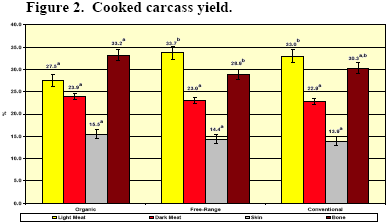
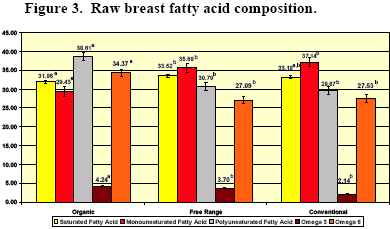
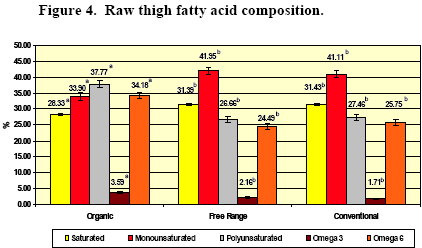
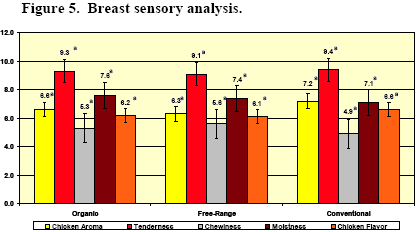
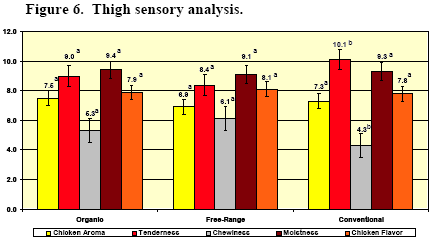
Further Information
To view other articles from the Animal Industry Report 2007 click hereMarch 2007








